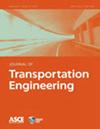局部扰动下面向乘客的城市轨道交通网络弹性评价
Q Engineering
引用次数: 0
摘要
在日常运行中,城市轨道交通(URT)系统经常会遇到导致运输能力部分减少的干扰[部分干扰(pd)],而不是导致运输能力完全减少的干扰。然而,评估pd下URT网络弹性的研究仍然有限。本文通过考虑乘客的出行行为以及速度系数与故障严重程度之间的不同关系(线性、凹形和凸形),提出了一种面向乘客的轨道交通网络弹性评估模型,解决了这一空白。提出了一种基于仿真的评估方法来求解弹性评估模型。对中国成都地铁网络进行了数值试验。结果表明,本文所采用的性能指标反映了乘客出行时间分布对网络性能的影响。故意pd比随机pd造成更大的性能损失。考虑速度系数与故障严重程度之间的凸关系,网络在pd下的弹性最小。每条线路基于弹性的关键环节不是固定的,而是随着故障严重程度和扰动发生时间的变化而变化。增加pd的故障严重程度会导致比增加pd数量更严重的性能损失。此外,可以通过提高乘客的可容忍延迟时间和干扰持续时间来增强轨道交通网络面向乘客的弹性。本文章由计算机程序翻译,如有差异,请以英文原文为准。
Passenger-Oriented Resilience Assessment of an Urban Rail Transit Network under Partial Disturbances
In daily operation, urban rail transit (URT) systems often experience disturbances that result in a partial reduction in transport capacity [partial disturbances (PDs)] rather than disturbances leading to a complete reduction in transport capacity. However, research that assesses the resilience of URT networks under PDs remains limited. This paper addresses this gap by proposing a passenger-oriented resilience assessment model for URT networks under PDs, considering the travel behaviors of passengers and different relations (i.e., linear, concave, and convex) between the velocity coefficient and failure severity. A simulation-based assessment approach was developed to solve the resilience assessment model. A numerical experiment was conducted on the Chengdu subway network in China. The results demonstrate that the performance indicator employed herein reflects the impact of passenger travel time distribution on network performance. Deliberate PDs cause more significant performance losses than random PDs. Moreover, the network is the least resilient under PDs considering the convex relation between the velocity coefficient and failure severity. The resilience-based critical link of each line is not fixed and varies with the failure severity and disturbance occurrence time. Increasing the failure severity of PDs results in more severe performance losses than increasing the number of PDs. Additionally, the passenger-oriented resilience of a URT network can be enhanced by improving the passengers’ tolerable delay time and disturbance duration.
求助全文
通过发布文献求助,成功后即可免费获取论文全文。
去求助
来源期刊

Journal of Transportation Engineering
工程技术-工程:土木
CiteScore
1.22
自引率
0.00%
发文量
0
审稿时长
3.6 months
期刊介绍:
Information not localized
 求助内容:
求助内容: 应助结果提醒方式:
应助结果提醒方式:


